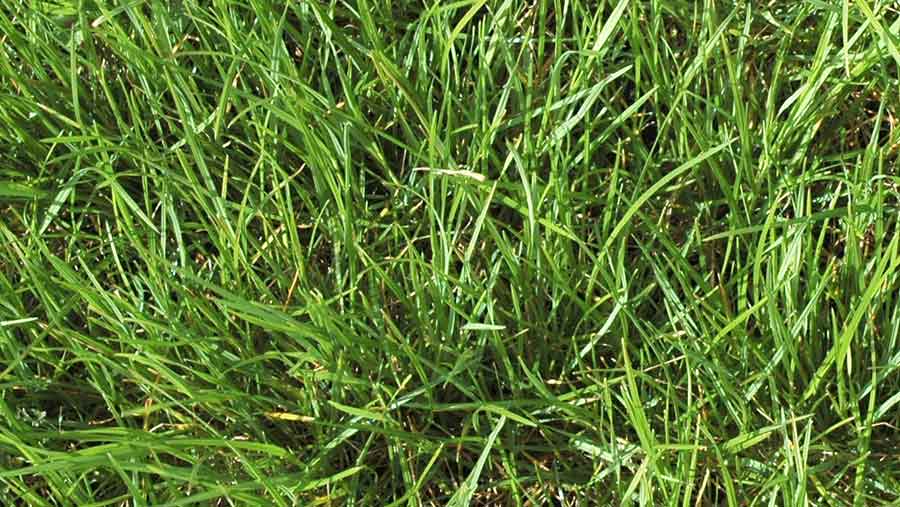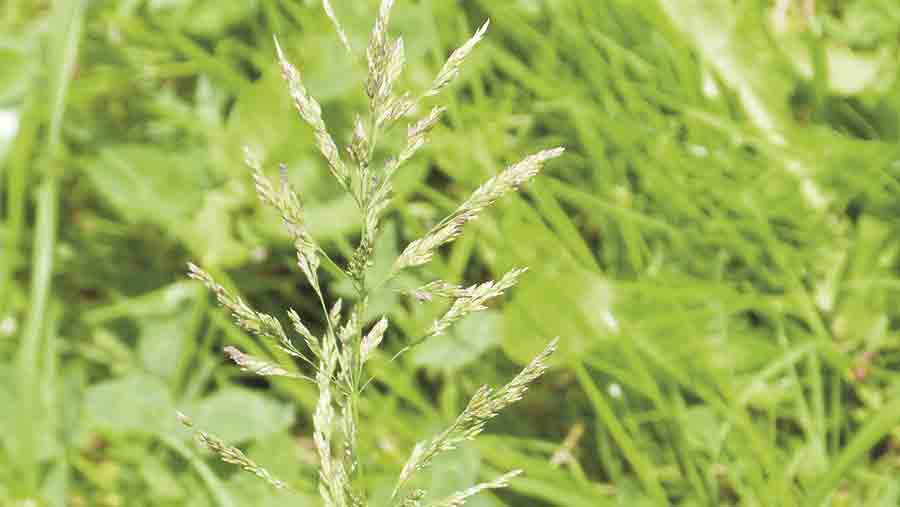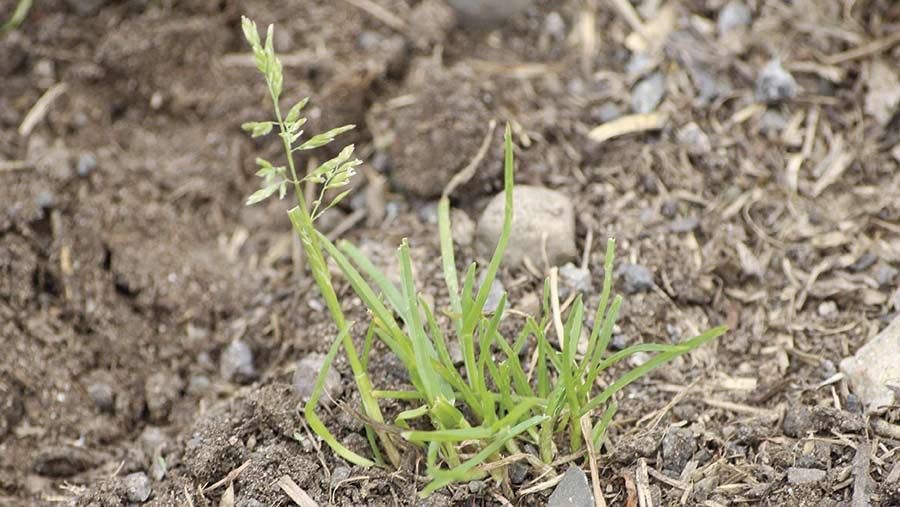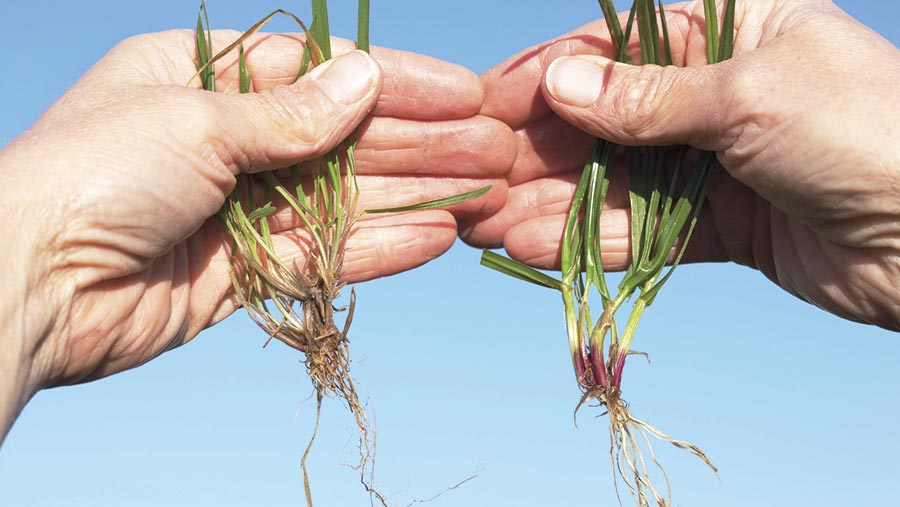Guide to spotting grassweeds and assessing pasture for reseed
A significant weed grass intrusion into a sward can significantly affect sward performance by reducing overall dry matter yield, nutritional quality and the response to nitrogen.
The main weed grasses include: Yorkshire fog, creeping bent, rough-stalked meadowgrass, annual meadowgrass, red fescue, creeping grass, couch and sheep’s fescue.
When weed grasses are present they will impact on sward performance (see table).
See also: 5 fundamentals to achieve healthy soils
For example, creeping fog (or soft grass) populates under-utilised grassland and shady areas across all soil types; it is very low in yield, quality and palatability.
Couch can be found in many grassland areas, spreading extensively from its creeping wiry rhizomes. Sheep’s fescue is common on poorer shallow soils and is quite nutritious for sheep, but very low yielding.
Attributes of major weed grasses compared with modern perennial ryegrass – scale of performance deficit |
||||||
|
|
Perennial ryegrass |
Yorkshire fog |
Creeping bent |
Rough-stalked meadowgrass |
Annual meadowgrass |
Red fescue |
|
DM yield (t DM/ha) |
15- 16 |
10 – 11 |
6 – 8 |
9 – 10 |
Negligible |
Negligible |
|
Average ME (MJ/kg DM) |
12.0 |
10.5 |
9.0 |
9.5 |
n/a |
n/a |
|
Response to nitrogen (% of PRG) |
100 |
42 |
33 |
17 |
n/a |
n/a |
|
Comments |
Native UK grass bred for a century for agronomic and nutritional improvements. Hairy and unpalatable. |
Grows in clumps and makes poor quality forage |
Colonises fields with poor fertility or under utilisation |
Stoloniferous growth habit and common in both grazing and silage leys |
Germinates all year round. Widespread in all soils types and locations |
Common on poorer shallow soils. Very low yielding |
|
Source: J Frame, “Herbage productivity and quality of a range of secondary grass species at five rates of nitrogen fertiliser applications”. Grass and Forage Science, 1991. |
||||||

Perennial ryegrass

Yorkshire fog

Creeping bent

Rough meadowgrass

Annual meadowgrass

Red fescue
How can reseeding help?
According to Helen Mathieu of Germinal, the combined impact of lower yield and quality means the cost of a reseed (typically £200/acre) can easily be recovered in the first year.
“We’d conservatively expect a new ley to yield 25% more dry matter in the first year and have 10 units of higher D-value,” she says.
Where there is enough grass to satisfy increased appetite, Ms Mathieu reckons each additional D-value unit increases milk yield in dairy cows by about 0.25 litres a cow a day.
In beef cattle, one unit of “D” increases growth rates by 40g a head a day and in lambs it is worth an additional 20g a head a day.
She says: “Add to this a significantly better response to nitrogen and a longer productive season and you can very quickly see a big return on investment.”
Guide to assessing your sward
Helen Mathieu’s from Germinal talks through how to assess your sward
1. Assess field performance
There are no hard and fast rules on how long a sward will last as there are so many variables, such as soil type and condition, soil nutrient levels, stocking density, degrees of poaching, management, and so on.
Make a rough assessment on how different fields are performing relative to the preceding seasons. This can be as simple as recording grazing days or stock carrying capacity, or the number of trailers taken at first cut.
Alternatively, you can observe how settled stock are, or – in the case of milk producers – if a field is impacting negatively on the bulk tank. Whatever your method, the key point is to take a closer look if there is any drop-off in performance.
What do new leys offer?
- 25% more dry matter yield in year one
- 10 unit of extra D-value
- 500% better response to nitrogen
- Up to 90 days of extra grazing per season
2. Assess proportion of sward still made up of the original main sown species (perennial ryegrass)
Sward assessments should be carried out twice a year, ahead of spring or early autumn reseeding opportunities.
Each inspection should be carried out at a minimum of 10 randomly selected points per field.
Walk in a “W” across the field to achieve the best representative sample.
3. Assess ground cover
Make a visual assessment of the field to see how much bare soil there is relative to herbage. In the case of a medium or long-term ley, anything less than 90% ground cover means your sward needs some attention.
Shorter-term leys, or those containing red clover, may be acceptable with lower ground cover.
Whether a full reseed or an overseeding renovation is required will depend on what the actual plant density and ground cover is made up of.
4. Assess for broad-leaved weeds
The most likely offenders will be docks, thistles, nettles, chickweed and cleavers, all being relatively easy to spot and, if there are significant numbers, will be a major drain on productivity.
Anything over 10% should prompt immediate action, with the recommended approach again depending on what else you find.
5. Identify amount of perennial ryegrass

However good your management, the amount of perennial ryegrass in a sward will deteriorate in time.
The common understanding is that beyond six years, it is quite possible that half the grasses in the sward will be weed grasses.
Perennial ryegrass can be distinguished from most other grasses by its red stem base (see image above).
It also has a shiny underside to the leaf. The aim is to have as much as possible of your sward made up of perennial ryegrass, with anything less than two-thirds being a trigger for action.
6. Assess white clover content
Where white clover is included in a sward, it needs to be part of the assessment.
White clover content will fluctuate through the year, with higher levels likely to occur during the summer months.
The target for optimum sward performance is an average of about 30% through the year, but you need to be aware that actual sward dry matter content is typically double the visual appearance.
As too much clover can be a problem as well as too little; anything outside a range of 20%-40% should prompt action.
